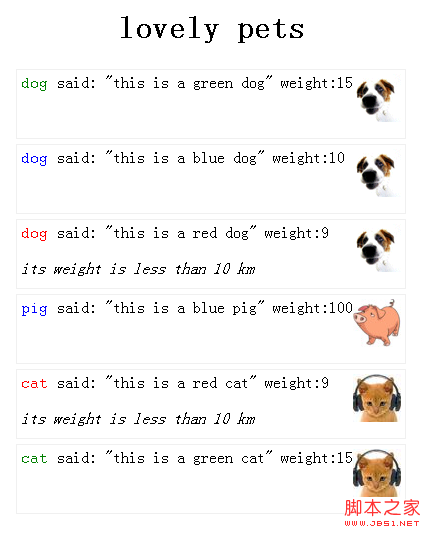
1) xsl:template定義匹配節點的轉換模板,屬性match=”xpath expression”用來定義模板匹配的元素
如下定義匹配根節點的模板
復制代碼 代碼如下:
<xsl:template match=”/”>
</xsl:template>
2) xsl:for-each循環顯示select=”xpath expression”選擇節點的轉換 (類似編程語言中的foreach語句),
如下示例,選擇了pets下面的子元素,並循環顯示子元素的幾點名字:
復制代碼 代碼如下:
<xsl:for-each select=”/pets/*”>
<xsl:value-of select=”name()”/>
</xsl:for-each>
3) xsl:if 元素條件顯示節點(類似編程語言中的if語句)注意小於號大於號要分別用<和>替代
復制代碼 代碼如下:
<xsl:if test=”@weight < 10”>
<i>its weight is less than 10 km</i>
</xsl:if>
4) xsl:choose 多分支條件顯示 (類似編程語言中的switch語句)
復制代碼 代碼如下:
<xsl:choose >
<xsl:when test=”name() = ‘pig'”>
<i>this is a pig</i>
</xsl:when>
<xsl:otherwise>
<i>this is not a pig</i>
</xsl:otherwise>
</xsl:choose>
5) xsl:value-of 顯示選擇節點或者屬性的值
選擇子節點price
<xsl:value-of select=”pets/*/price”/>
選擇屬性weight
<xsl:value-of select=”pets/*/@weight”/>
6) xsl:attribute 構造xml節點的屬性
用來向節點添加屬性,例如:
<font>
<xsl:attribute name=”color”><xsl:value-of select=”pets/*/@color”/></xsl:attribute>
</font>
將輸出<font color=”red”></font>
7) xsl:apply-templates 應用模板
如果xml文件結構比較復雜,可以定義多個template,然後使用<xsl:apply-templates>標簽應用模板,xsl:apply-templates 可以指定屬性select=”xpath”來選擇應用的模板,或者不指定select表示選擇當前節點的模板。
請看下面示例xslt文件pets-templates.xsl
完整的示例xsl文件:pets.xsl
復制代碼 代碼如下:
<?xml version="1.0" encoding="utf-8"?>
<xsl:stylesheet version="1.0"
xmlns:xsl="http://www.w3.org/1999/XSL/Transform">
<xsl:template match="/">
<html>
<head>
<META http-equiv="Content-Type" content="text/html; charset=utf-8"/>
<title>lovely pets</title>
<style type="text/css">
ul{margin:10px 0 10px 0;padding:0;width:400px;text-align:left;}
li{height:60px;display:block;list-style:none;padding:4px;border:1px solid #f0f0f0;margin:5px;}
</style>
</head>
<body>
<center>
<h1>lovely pets</h1>
<ul>
<xsl:for-each select="pets/*">
<li>
<img align="right">
<xsl:choose>
<xsl:when test="name() = 'dog'">
<xsl:attribute name="src">http://estar-tv.com/images/comprofiler/gallery/dog.gif</xsl:attribute>
</xsl:when>
<xsl:when test="name() = 'pig'">
<xsl:attribute name="src">http://www.icosky.com/icon/thumbnails/Animal/Farm/Pig%20Icon.jpg</xsl:attribute>
</xsl:when>
<xsl:otherwise>
<xsl:attribute name="src">http://farm1.static.flickr.com/14/buddyicons/[email protected]?1143660418</xsl:attribute>
</xsl:otherwise>
</xsl:choose>
</img>
<font>
<xsl:attribute name="face">Courier</xsl:attribute>
<xsl:attribute name="color">
<xsl:value-of select="@color"/>
</xsl:attribute>
<xsl:value-of select="name()"/>
</font> said: "<xsl:value-of select="desc"/>"
weight:<xsl:value-of select="@weight"/>
<xsl:if test="@weight < 10">
<p>
<i>its weight is less than 10 km</i>
</p>
</xsl:if>
</li>
</xsl:for-each>
</ul>
</center>
</body>
</html>
</xsl:template>
</xsl:stylesheet>
完整示例文件 pets-templates.xsl:
復制代碼 代碼如下:
<?xml version="1.0" encoding="utf-8"?>
<xsl:stylesheet version="1.0"
xmlns:xsl="http://www.w3.org/1999/XSL/Transform">
<xsl:template match="/">
<html>
<head>
<META http-equiv="Content-Type" content="text/html; charset=utf-8"/>
<title>lovely pets</title>
<style type="text/css">
ul{margin:10px 0 10px 0;padding:0;width:400px;text-align:left;}
li{height:60px;display:block;list-style:none;padding:4px;border:1px solid #f0f0f0;margin:5px;}
</style>
</head>
<body>
<center>
<h1>lovely pets</h1>
<ul>
<xsl:apply-templates select="pets" />
</ul>
</center>
</body>
</html>
</xsl:template>
<xsl:template match="pets">
<xsl:apply-templates select="dog"></xsl:apply-templates>
<xsl:apply-templates select="pig"></xsl:apply-templates>
<xsl:apply-templates select="cat"></xsl:apply-templates>
</xsl:template>
<xsl:template match="dog">
<xsl:for-each select=".">
<li>
<img align="right">
<xsl:attribute name="src">http://estar-tv.com/images/comprofiler/gallery/dog.gif</xsl:attribute>
</img>
<font>
<xsl:attribute name="face">Courier</xsl:attribute>
<xsl:attribute name="color">
<xsl:value-of select="@color"/>
</xsl:attribute>
dog
</font> said: "<xsl:value-of select="desc"/>"
weight:<xsl:value-of select="@weight"/>
<xsl:if test="@weight < 10">
<p>
<i>its weight is less than 10 km</i>
</p>
</xsl:if>
</li>
</xsl:for-each>
</xsl:template>
<xsl:template match="pig">
<xsl:for-each select=".">
<li>
<img align="right">
<xsl:attribute name="src">http://www.icosky.com/icon/thumbnails/Animal/Farm/Pig%20Icon.jpg</xsl:attribute>
</img>
<font>
<xsl:attribute name="face">Courier</xsl:attribute>
<xsl:attribute name="color">
<xsl:value-of select="@color"/>
</xsl:attribute>
pig
</font> said: "<xsl:value-of select="desc"/>"
weight:<xsl:value-of select="@weight"/>
<xsl:if test="@weight < 10">
<p>
<i>its weight is less than 10 km</i>
</p>
</xsl:if>
</li>
</xsl:for-each>
</xsl:template>
<xsl:template match="cat">
<xsl:for-each select=".">
<li>
<img align="right">
<xsl:attribute name="src">http://farm1.static.flickr.com/14/buddyicons/[email protected]?1143660418</xsl:attribute>
</img>
<font>
<xsl:attribute name="face">Courier</xsl:attribute>
<xsl:attribute name="color">
<xsl:value-of select="@color"/>
</xsl:attribute>
cat
</font> said: "<xsl:value-of select="desc"/>"
weight:<xsl:value-of select="@weight"/>
<xsl:if test="@weight < 10">
<p>
<i>its weight is less than 10 km</i>
</p>
</xsl:if>
</li>
</xsl:for-each>
</xsl:template>
</xsl:stylesheet>
在c#.net中使用XslCompiledTransform轉換xml文檔,XslTransform也可以使用,但是這個類已經被微軟標記為過時,最好不要再用了,如下代碼示例:
復制代碼 代碼如下:
using System;
using System.Collections.Generic;
using System.Linq;
using System.Text;
using System.IO;
using System.Xml;
namespace UseXslt
{
class Program
{
static void Main(string[] args)
{
//聲明XslTransform類實例
System.Xml.Xsl.XslCompiledTransform trans = new System.Xml.Xsl.XslCompiledTransform();
string xsltFile = @"X:\about.net\System.Xml\example\pets.xsl";
using (StreamReader rdr = new StreamReader(xsltFile))
{
using (XmlReader xmlRdr = XmlReader.Create(rdr))
{
//載入xsl文件
trans.Load(xmlRdr);
}
}
string inputFile = @"X:\about.net\System.Xml\example\pets.xml";
string outputFile = @"X:\about.net\System.Xml\example\pets-out.htm";
//轉化源文件輸出到輸出文件outputFile
trans.Transform(inputFile, outputFile);
}
}
}
有一點需要注意,使用XslCompiledTransform轉換出來的文件,是一個html格式的,這個類會自動在html的head標簽中添加一個未關閉的meta標簽 <META http-equiv="Content-Type" content="text/html; charset=utf-8">;微軟幫我們想的太多了。
Xslt還可以指定參數,定義變量,有關這些方面請查看相關文檔。